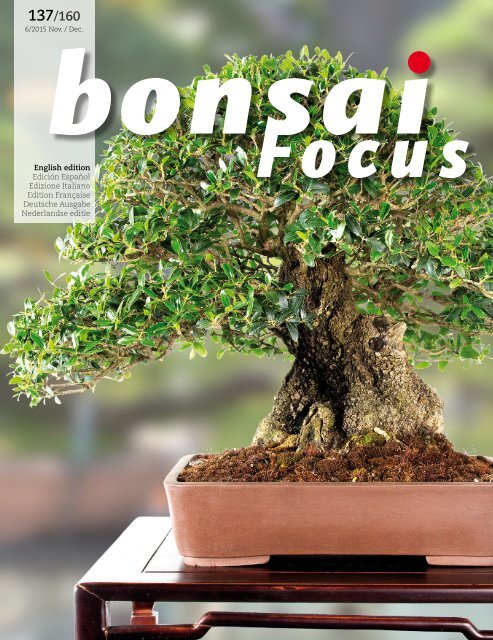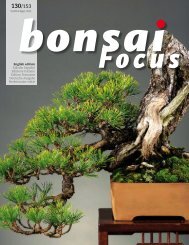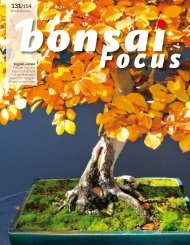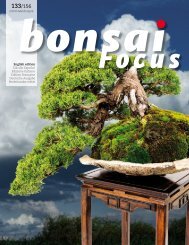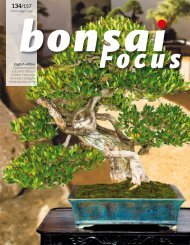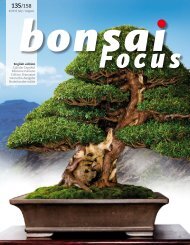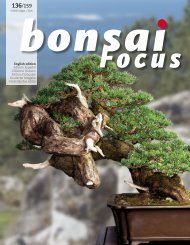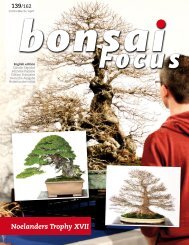BONSAI FOCUS 2015-6 EN PREVIEW
Discover how fascinating Bonsai Focus is! With informative reports and stunning photography every two months, Bonsai Focus Magazine makes you eye-witness extraordinary bonsai, magnificent stylings of famous masters, educational techniques and useful maintenance tips. Articles are often supported by exclusive and breathtaking videos.
Discover how fascinating Bonsai Focus is! With informative reports and stunning photography every two months, Bonsai Focus Magazine makes you eye-witness extraordinary bonsai, magnificent stylings of famous masters, educational techniques and useful maintenance tips. Articles are often supported by exclusive and breathtaking videos.
Create successful ePaper yourself
Turn your PDF publications into a flip-book with our unique Google optimized e-Paper software.
137/160<br />
6/<strong>2015</strong> Nov. / Dec.<br />
English edition<br />
Edición Español<br />
Edizione Italiano<br />
Edition Française<br />
Deutsche Ausgabe<br />
Nederlandse editie
Bonsai Focus<br />
EDITORIAL<br />
3<br />
Who we are<br />
Publisher<br />
Bonsai Europe Publications<br />
Houtrustweg 96,<br />
2566 GJ The Hague<br />
The Netherlands<br />
Europe:<br />
Tel.: +31 (0)85 90 20 900<br />
Office hours: 9am - 5pm (CET)<br />
USA:<br />
Tel.:(+1) 703-738-9965<br />
Office hours: 9am - 5pm (East Coast)<br />
E-mail:<br />
info@bonsaifocus.com<br />
Website:<br />
www.bonsaifocus.com<br />
Chief Editor:<br />
Farrand Bloch<br />
editor@bonsaifocus.com<br />
The 'rocky' garden of David Benavente with some of his famous pines<br />
Editorial staff:<br />
English edition: Ann Scutcher<br />
French edition: Patrick Bosc, Matthieu<br />
Mavridis<br />
German edition: Jörg Derlien<br />
Dutch edition: Hein-Dik Barentsen<br />
Italian edition: Erika Lakin<br />
Spanish edition: Ana Ricart<br />
Advertising & Marketing:<br />
René Rooswinkel<br />
sales@bonsaifocus.com<br />
Subscriptions & Administration:<br />
Marja Heijmink<br />
admin@bonsaifocus.com<br />
Issn UK: 1874 - 6853<br />
Issn US: 1876 - 6137<br />
Price:<br />
€ 11.95 | $ 14.95 | £ 9.95<br />
© Copyright <strong>2015</strong><br />
Bonsai Europe, world rights reserved. No<br />
part of this publication may be reproduced<br />
in any form without the written<br />
permission of the publisher.<br />
Two Masters<br />
David Benavente, whom I met last year during the Alcobendas show in Madrid, invited<br />
me to see his bonsai garden. It was a short trip by car from the show to his garden<br />
located in the mountains just outside Madrid. We drove up a winding road and slowly<br />
the landscape changed; rocks and pines dominated the view and suburban towns<br />
were left behind us. His garden was even more stunning, it had natural granite rocks<br />
and a great collection of amazing trees. Time did not permit us to do a photoshoot<br />
with him, so we decided instead that he would write an article for us. You can read it<br />
in this issue, a styling with a grand yew, masterly done. 'It is a tree I fell in love with<br />
right from the start,’ David explains. 'Together with my great help, Pablo Comesana,<br />
who did the photography and artwork, we managed to capture the development of<br />
this tree.' The result is stunning and we are hoping to feature David more often in our<br />
magazine.<br />
A new masterclass comes from Hotsumi Terakawa, a regular guest, with work on a<br />
juniper that was being totally restyled in the clean, plain style so typical Hotsumi. The<br />
tree has a very elegant winding shape crowned with an impressive piece of deadwood.<br />
We feature another garden worth visiting, this time very close to Düsseldorf, Germany.<br />
It contains the works of Werner Busch who is famous for his knowledge of native<br />
trees. Find a selection of them in the gallery pages of this issue.<br />
Enjoy the read,<br />
Bonsai Focus has a co-operation with<br />
Kinbon magazine, Kyoto, Japan<br />
Translations:<br />
Peter Warren<br />
Farrand Bloch<br />
Chief editor
4 Bonsai Focus<br />
THIS ISSUE<br />
Our Icons<br />
Video available<br />
bonsaifocus.com<br />
Scan the code<br />
with your phone<br />
Beginner<br />
Advanced<br />
Expert<br />
On the cover<br />
Phillyrea<br />
Height: 32 cm / 12".<br />
Owner: Angelo Sartoriello.<br />
Photo: Bonsai Focus Studio<br />
6<br />
6 The greatness in small things<br />
The Bonsai Museum in Düsseldorf, Germany<br />
8 Incredible skills<br />
Craftsmen show off their skills and combine them with bonsai<br />
12 Bonsai grooming<br />
What to do after a long growing season<br />
14 Life flows through the veins<br />
Hotsumi Terakawa styles a juniper<br />
14<br />
22 Like a sponge<br />
The bonsai passion of Milan Karpíšek.<br />
24 Pyracantha shohin<br />
Simple adjustments to a firethorn<br />
30 Expert opinion<br />
François Jeker analyses David Molin's Taxus baccata<br />
32 Technique<br />
Create lots of bonsai by air layering<br />
38
Bonsai Focus<br />
38 Gallery<br />
A selection of the best trees from the Düsseldorf Museum<br />
40 Step by step<br />
Jean-Philippe Hoareau works on a small native pine<br />
44 Webshop<br />
Various products at special prices for subscribers<br />
46 Masterclass with David Benavente<br />
A huge Japanese yew caught David's eye.<br />
58 No need to win<br />
Rock plantings with accent plants<br />
46<br />
60 Maintaining beech<br />
The best time to pinch for a beautiful branch setting<br />
68 Gallery<br />
A selection of the best trees from the Düsseldorf Museum<br />
60<br />
71 Tony's column<br />
Tony Tickle asks how we can change the distorted perception of<br />
bonsai<br />
72 Sowing the seeds<br />
The challenge to grow an elm from seed<br />
78 The local beauty<br />
The specially designed pots of Laurence and Gilles<br />
8
Bonsai Focus<br />
TRAVEL<br />
7<br />
Large display panels explain the history of bonsai<br />
Cascade larch (Larix kaempferi)<br />
Plenty of native trees to enjoy in the museum<br />
Above: A massive field maple (Acer campestre)<br />
Below: Overview of the exhibits<br />
Larch (Larix kaempferi)<br />
Where to find the Bonsai Museum<br />
Address: Hammer Dorfstrasse 167,<br />
40221 Düsseldorf, Germany<br />
Tel: +49 211 306773<br />
Open 1st March to 31st October:<br />
Monday to Friday, 14:30 until 18:30.<br />
Saturday and Sunday, 10:00 until 17.00.<br />
From 1st November to 28th February: you can visit<br />
the museum, but by appointment only.<br />
More info: www.bonsai-museum.de<br />
Or: www.bonsaiwerkstatt.de
12 Bonsai Focus<br />
MAINT<strong>EN</strong>ANCE<br />
Bonsai Grooming<br />
What to do after a long growing season<br />
How mechanism in the leaf retains sugar<br />
Summer daytime<br />
Sunlight<br />
Sugar<br />
Water<br />
CO2<br />
Carbon dioxide from the atmosphere is converted into sugars and<br />
chlorophyll in the leaves is an essential part of that process<br />
Text and photography: Kinbon magazine, Japan<br />
Acer palmatum on Shikoku Island, Japan<br />
Summer nights<br />
Water<br />
Beautiful autumnal colours<br />
Acers are one of the most widely appreciated species in the<br />
autumn when their foliage reminds us of the season. Trees in<br />
nature will create very beautiful colours if they are given the<br />
correct conditions and health; however, it is much more difficult<br />
to achieve the same level in bonsai. It's impossible to control<br />
every aspect of the tree, but here are a few tips for creating more<br />
beautiful autumn colours.<br />
Sugar<br />
CO2<br />
Sugar<br />
Sugars are transported to other areas of the tree or used in respiration<br />
The changing of colours occurs when the average temperature<br />
is less than 7 degC / 44 degF for approximately two to three<br />
weeks continuously. If the temperature drops below 5 degC /<br />
41 degF this speeds up dramatically. The colour change of the<br />
foliage to red, yellow or orange depends greatly on the sugar<br />
content of the leaves, which is generated via photosynthesis.<br />
Once the temperature drops down, demand for those sugars<br />
also drops and they are retained by the leaves and change into<br />
anthocyanin which creates the deep red colours. The higher the<br />
concentration of sugar, the deeper the colour<br />
Autumn night time<br />
Sugar<br />
Water<br />
So as to create the most beautiful autumn colour, it's essential<br />
to have the trees in full sun during the day and allow them to<br />
cool down at night. This is especially important, so place trees<br />
in a position where they will receive cool conditions at night,<br />
without freezing, and a good air flow.<br />
Corky membrane<br />
CO2<br />
Once we are into October, stop fertilising and, particularly in<br />
urban areas, regularly wash foliage by misting during day-time<br />
watering.<br />
A corky membrane starts to form at the base of the leaf, stopping the<br />
flow of sugars which remain in the leaf
Bonsai Focus<br />
PROFILE<br />
23<br />
Pinus mugo<br />
Which trees do you most like to<br />
work on?<br />
I prefer to work with pine and juniper.<br />
From deciduous trees I love working<br />
on Japanese maple or on European and<br />
Japanese beech. For a long time now I've<br />
chosen these varieties and try to learn<br />
everything about them. It is clear to me<br />
that the more varieties I grow, the less I'll<br />
know about them. That's why I'm going<br />
to concentrate on these four species that<br />
fascinate me and which I really like.<br />
Juniperus sabina<br />
Juniperus sabina<br />
Do you favour the Japanese or<br />
Western bonsai style?<br />
I prefer the Japanese style because of its<br />
qualitative, precise and long-term work.<br />
I do not like Western style, because it is<br />
too fast and tries to imitate the Japanese<br />
bonsai too quickly. The western trees miss<br />
the so-called mochikomi — long term<br />
maintenance.<br />
“<br />
Western trees miss the mochikomi<br />
PInus sylvestris<br />
Have you a favourite bonsai?<br />
I don't really have a favourite tree. In<br />
every tree I find something interesting.<br />
What is your best achievement?<br />
I came first in the new talent competition<br />
in the Czech Republic and second place in<br />
the New Talent Competition at the EBA,<br />
Lorca, Spain 2009.<br />
Assisting Seok Ju Kim during the Nöelanders Trophy in<br />
January, <strong>2015</strong>
38 Bonsai Focus<br />
STEP BY STEP<br />
Double loop<br />
Jean-Philippe Hoareau works on a small, native-grown pine<br />
Since he first appeared in our magazine, September<br />
2014, JP's knowledge has grown tremendously — so<br />
has his beard . . .<br />
Text and photography: Bonsai Focus Studio<br />
Home-grown scots pines from Giacomo<br />
1<br />
Pappalardo's nursery prove yet again to be<br />
great material to work on. Jean-Philippe<br />
Hoareau, or simply JP, leads you through<br />
the styling process step by step<br />
Analysing the tree<br />
JP: 'I chose this pine from a big selection; I was attracted<br />
by the looping trunk and the lower branch. These are<br />
interesting features.'<br />
JP: 'By plucking the tree's old needles you are already examining its options'<br />
A 'blob' of branches<br />
at the top<br />
Interesting curves<br />
Removing the old needles with fine<br />
shears<br />
The result after cleaning the<br />
branches<br />
Careful plucking<br />
If you use your hands to pluck the<br />
needles, pull out the needle pairs<br />
with care by easing outwards, not by<br />
ripping them backwards.<br />
A very fine branch with plenty of<br />
well-developed side branches
68 GALLERY<br />
Bonsai Focus<br />
Prunus<br />
Bonsai Museum Düsseldorf<br />
60cm | 23"<br />
Larix kaempferi<br />
Bonsai Museum Düsseldorf<br />
55cm | 21"<br />
Ligustrum<br />
Bonsai Museum Düsseldorf<br />
60cm | 23"
Bonsai Focus<br />
NEWS<br />
69<br />
Artisans cup<br />
sets new standard for a bonsai<br />
exhibition<br />
Randy Knight (left) Chelsea and Ryan Neil<br />
During the weekend of the 25th tru 27th<br />
this event, which was organised by Ryan<br />
and Chelsea Neil, was held at the Portland<br />
art museum in Oregon USA. Bonsai Focus<br />
was there to witness this amazing show,<br />
we will do a full report in the January issue,<br />
but give you some preview photos of<br />
the highlights<br />
First prize Winner of the Artisans cup is Randy<br />
Knight, with a rocky mountain juniper
Bonsai Focus<br />
NEXT ISSUE<br />
81<br />
Issue 138 January / February<br />
Very practical<br />
Hints, tips, dos and don'ts to help improve your bonsai<br />
Team work<br />
Giacomo Pappalardo works on a sabina juniper together with<br />
his team of students<br />
Masahiko Kimura<br />
The masterly touch of Kimura brings a juniper back to life<br />
Satsuki on the rocks<br />
Quite unusual to plant satsukis on rock — even more surprising<br />
to make whole landscapes with them
For the complete<br />
Subscribe now!!<br />
You are just<br />
one click away!!


